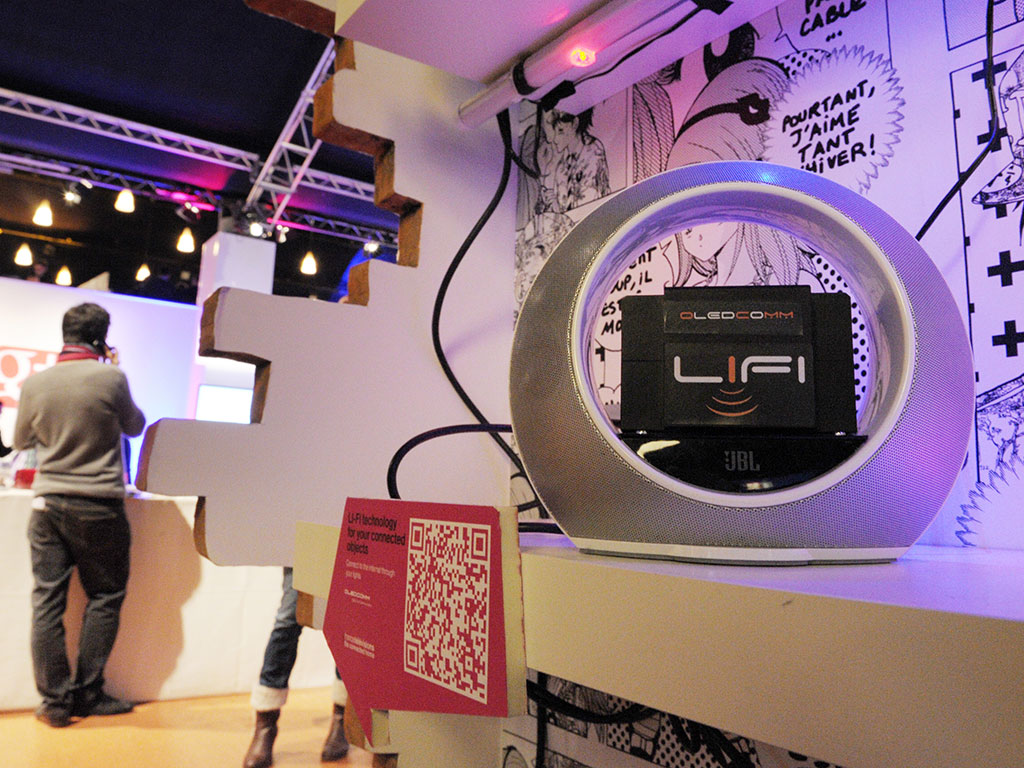LiFi could revolutionise internet connectivity
LiFi technology offers an alternative form of wireless communication, one that is 10 times faster than Wi-Fi. And all you need is a lightbulb

LiFi on display in Paris. The technology provides wireless internet connection via light signals rather than radio waves. That means it doesn't cause the sort of interference Wi-Fi can, but also renders it useless in certain situations (e.g. in direct sunlight)
Visible light communications (VLC), referred to as LiFi, uses technology that can transmit data at a speed as fast as one gigabit per second (Gbps) using an LED light bulb. At 10 times faster than the current technology (according to pureLifi), LiFi offers huge speed advantages, a reduction in device interference and securer communications. According to Transparent Market Research, VLC technology is expected to reach a value of $113bn by 2022. Already installed in various customer premises, LiFi has the potential to revolutionise connectivity.
The origins of LiFi
VLC technology was first brought to popular attention during a 2011 TED Talk by physicist Harold Haas, a professor of mobile communications at the University of Edinburgh. Introducing LiFi as a means of using light bulbs as wireless routers, he claimed the technology would “combine two basic functionalities[,] illumination and wireless data transmission” to overcome the current problems facing Wi-Fi. Spectators were quick to disregard it as having any real impact in communication technology. A year after the talk, Haas joined forces with people in the same field of research, creating pureLiFi. Haas and the company have been recognised as the leaders in LiFi technology, and have since produced two products.
The LED light bulb transmitted data at a speed of 1 Gbps
After testing LiFi in the laboratory, showing theoretical speeds of 224 Gbps, start-up Velmenni piloted the technology in an actual working environment. The LED light bulb transmitted data at a speed of 1 Gbps, as opposed to Wi-Fi’s average speed of 3.4 Megabits per second.
On 11 November last year, pureLiFi announced a partnership with a French industrial-lighting company, which will introduce the firm’s VLC technology in its products by the third quarter of 2016. The world’s first fully industrialised LiFi light will be installed at the headquarters of Sogeprom in La Défence, Paris.
How to get the internet through your lightbulb
For the technology to work it needs an LED bulb, an internet connection and a photo-detector. The LED bulb with signal-processing technology streams, at ultra-high speeds, to the photo-detector. A receiver dongle then converts the small changes in amplitude into an electrical signal, which is then converted back into a data stream and transmitted to a computer or mobile device.
During his TED Talk, Haas claimed infrastructure would allow every single LED light bulb to be transformed, and insisted there would be wireless access delivering high-speed connectivity wherever there was light. He said: “In the future, we will not only have 14bn light bulbs, we may have 14bn LiFis deployed worldwide for a cleaner, greener, brighter future.”
On top of its ultra-high speed and accessibility, the technology holds an extra advantage in regards to interference problems. Unlike Wi-Fi and the radio waves, LiFi does not interfere with radio signals, so it could be utilised on aircraft and other areas where interference is an issue. PureLiFi outlines other competitive advantages, which include improvements to security, localisation and safety.
The technology is not without its disadvantages, however. LiFi is highly effective within the home or the office when all the lights are turned on, but its dependence on light means it lacks the capacity to transmit through walls. The technology is also unusable outside during the day as direct sunlight interferes with its signal. So while LiFi may be a contender within the home, it is unable to compete with public Wi-Fi. Critics further argue any blocking or movement affecting the light may interrupt the signal to the device. Haas dismissed this, claiming: “In a room, this will never happen.”
When asked how wireless communications compare, a pureLiFi spokesperson said: “LiFi will not replace Wi-Fi. LiFi will compliment the wireless connectivity for the user as part of a heterogeneous network offering.” She added: “The competitive advantages clearly show how LiFi is better suited for indoor environments relative to Wi-Fi, but even in that case it will not replace it entirely.”
LiFi may still be facing some obstacles, but pureLiFi is confident the technology will be on the market to buy within the next couple of years. According to the company: “The accelerating pace of technology means that LiFi will come as a mass market product quicker than most people can imagine.” It is a very real possibility that LiFi could become the dominant means of communication in the near future.













